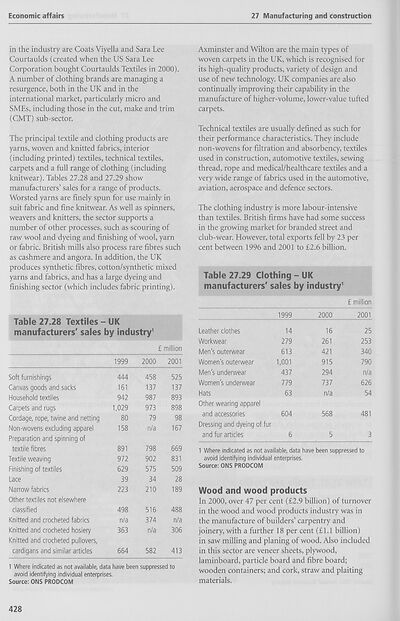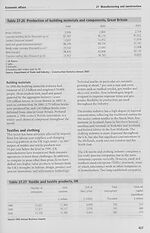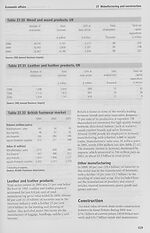Download files
Complete book:
Individual page:
Thumbnail gallery: Grid view | List view

Economic affairs
27 Manufacturing and construction
in the industry are Coats Viyella and Sara Lee
Courtaulds (created when the US Sara Lee
Corporation bought Courtaulds Textiles in 2000).
A number of clothing brands are managing a
resurgence, both in the UK and in the
international market, particularly micro and
SMEs, including those in the cut, make and trim
(CMT) sub-sector.
The principal textile and clothing products are
yarns, woven and knitted fabrics, interior
(including printed) textiles, technical textiles,
carpets and a full range of clothing (including
knitwear). Tables 27.28 and 27.29 show
manufacturers’ sales for a range of products.
Worsted yarns are finely spun for use mainly in
suit fabric and fine knitwear. As well as spinners,
weavers and knitters, the sector supports a
number of other processes, such as scouring of
raw wool and dyeing and finishing of wool, yarn
or fabric. British mills also process rare fibres such
as cashmere and angora. In addition, the UK
produces synthetic fibres, cotton/synthetic mixed
yarns and fabrics, and has a large dyeing and
finishing sector (which includes fabric printing).
Table 27.28 Textiles - UK
manufacturers' sales by industry1
£ million
1999 2000 2001
Soft furnishings 444 458 525
Canvas goods and sacks 161 137 137
Household textiles 942 987 893
Carpets and rugs 1,029 973 898
Cordage, rope, twine and netting 80 79 98
Non-wovens excluding apparel 158 n/a 167
Preparation and spinning of
textile fibres 891 798 669
Textile weaving 972 902 831
Finishing of textiles 629 575 509
Lace 39 34 28
Narrow fabrics 223 210 189
Other textiles not elsewhere
classified 498 516 488
Knitted and crocheted fabrics n/a 374 n/a
Knitted and crocheted hosiery 363 n/a 306
Knitted and crocheted pullovers,
cardigans and similar articles 664 582 413
1 Where indicated as not available, data have been suppressed to
avoid identifying individual enterprises.
Source: ONS PRODCOM
Axminster and Wilton are the main types of
woven carpets in the UK, which is recognised for
its high-quality products, variety of design and
use of new technology. UK companies are also
continually improving their capability in the
manufacture of higher-volume, lower-value tufted
carpets.
Technical textiles are usually defined as such for
their performance characteristics. They include
non-wovens for filtration and absorbency, textiles
used in construction, automotive textiles, sewing
thread, rope and medical/healthcare textiles and a
very wide range of fabrics used in the automotive,
aviation, aerospace and defence sectors.
The clothing industry is more labour-intensive
than textiles. British firms have had some success
in the growing market for branded street and
club-wear. However, total exports fell by 23 per
cent between 1996 and 2001 to £2.6 billion.
Table 27.29 Clothing - UK
manufacturers' sales by industry1
£ million
1999
2000
2001
Leather clothes 14 16 25
Workwear 279 261 253
Men's outerwear 613 421 340
Women's outerwear 1,001 915 790
Men's underwear 437 294 n/a
Women's underwear 779 737 626
Hats 63 n/a 54
Other wearing apparel
and accessories 604 568 481
Dressing and dyeing of fur
and fur articles 6 5 3
1 Where indicated as not available, data have been suppressed to
avoid identifying individual enterprises.
Source: ONS PRODCOM
Wood and wood products
In 2000, over 47 per cent (£2.9 billion) of turnover
in the wood and wood products industry was in
the manufacture of builders’ carpentry and
joinery, with a further 18 per cent (£1.1 billion)
in saw milling and planing of wood. Also included
in this sector are veneer sheets, plywood,
laminboard, particle board and fibre board;
wooden containers; and cork, straw and plaiting
materials.
428
27 Manufacturing and construction
in the industry are Coats Viyella and Sara Lee
Courtaulds (created when the US Sara Lee
Corporation bought Courtaulds Textiles in 2000).
A number of clothing brands are managing a
resurgence, both in the UK and in the
international market, particularly micro and
SMEs, including those in the cut, make and trim
(CMT) sub-sector.
The principal textile and clothing products are
yarns, woven and knitted fabrics, interior
(including printed) textiles, technical textiles,
carpets and a full range of clothing (including
knitwear). Tables 27.28 and 27.29 show
manufacturers’ sales for a range of products.
Worsted yarns are finely spun for use mainly in
suit fabric and fine knitwear. As well as spinners,
weavers and knitters, the sector supports a
number of other processes, such as scouring of
raw wool and dyeing and finishing of wool, yarn
or fabric. British mills also process rare fibres such
as cashmere and angora. In addition, the UK
produces synthetic fibres, cotton/synthetic mixed
yarns and fabrics, and has a large dyeing and
finishing sector (which includes fabric printing).
Table 27.28 Textiles - UK
manufacturers' sales by industry1
£ million
1999 2000 2001
Soft furnishings 444 458 525
Canvas goods and sacks 161 137 137
Household textiles 942 987 893
Carpets and rugs 1,029 973 898
Cordage, rope, twine and netting 80 79 98
Non-wovens excluding apparel 158 n/a 167
Preparation and spinning of
textile fibres 891 798 669
Textile weaving 972 902 831
Finishing of textiles 629 575 509
Lace 39 34 28
Narrow fabrics 223 210 189
Other textiles not elsewhere
classified 498 516 488
Knitted and crocheted fabrics n/a 374 n/a
Knitted and crocheted hosiery 363 n/a 306
Knitted and crocheted pullovers,
cardigans and similar articles 664 582 413
1 Where indicated as not available, data have been suppressed to
avoid identifying individual enterprises.
Source: ONS PRODCOM
Axminster and Wilton are the main types of
woven carpets in the UK, which is recognised for
its high-quality products, variety of design and
use of new technology. UK companies are also
continually improving their capability in the
manufacture of higher-volume, lower-value tufted
carpets.
Technical textiles are usually defined as such for
their performance characteristics. They include
non-wovens for filtration and absorbency, textiles
used in construction, automotive textiles, sewing
thread, rope and medical/healthcare textiles and a
very wide range of fabrics used in the automotive,
aviation, aerospace and defence sectors.
The clothing industry is more labour-intensive
than textiles. British firms have had some success
in the growing market for branded street and
club-wear. However, total exports fell by 23 per
cent between 1996 and 2001 to £2.6 billion.
Table 27.29 Clothing - UK
manufacturers' sales by industry1
£ million
1999
2000
2001
Leather clothes 14 16 25
Workwear 279 261 253
Men's outerwear 613 421 340
Women's outerwear 1,001 915 790
Men's underwear 437 294 n/a
Women's underwear 779 737 626
Hats 63 n/a 54
Other wearing apparel
and accessories 604 568 481
Dressing and dyeing of fur
and fur articles 6 5 3
1 Where indicated as not available, data have been suppressed to
avoid identifying individual enterprises.
Source: ONS PRODCOM
Wood and wood products
In 2000, over 47 per cent (£2.9 billion) of turnover
in the wood and wood products industry was in
the manufacture of builders’ carpentry and
joinery, with a further 18 per cent (£1.1 billion)
in saw milling and planing of wood. Also included
in this sector are veneer sheets, plywood,
laminboard, particle board and fibre board;
wooden containers; and cork, straw and plaiting
materials.
428
Set display mode to:
![]() Universal Viewer |
Universal Viewer | ![]() Mirador |
Large image | Transcription
Mirador |
Large image | Transcription
The item on this page appears courtesy of Office for National Statistics and may be re-used under the Open Government Licence for Public Sector Information.
| Britain and UK handbooks > UK: The official yearbook of the United Kingdom of Great Britain and Northern Ireland > 2003 > (478) |
|---|
| Permanent URL | https://digital.nls.uk/204929327 |
|---|
| Attribution and copyright: |
|
|---|---|
| Description | Three volumes of 'UK: The official yearbook of the United Kingdom of Great Britain and Northern Ireland', published annually by the Office of National Statistics from 2002-2005. |
|---|---|
| Shelfmark | GII.11 SER |
| Description | Three titles produced by the British Government from 1954-2005 describing 'how Britain worked'. They are: 'Britain: An official handbook' (1954-1998), 'Britain: The official yearbook of the United Kingdom' (1999-2001), and 'UK: The official yearbook of the United Kingdom of Great Britain and Northern Ireland' (2002-2005). These 50 reports provide an overview of Britain's economic, social and cultural affairs, its environment, international relations, and the systems of government. They give an impartial summary of government policies and initiatives, and explain how public services are organised. |
|---|---|
| Additional NLS resources: |
|

